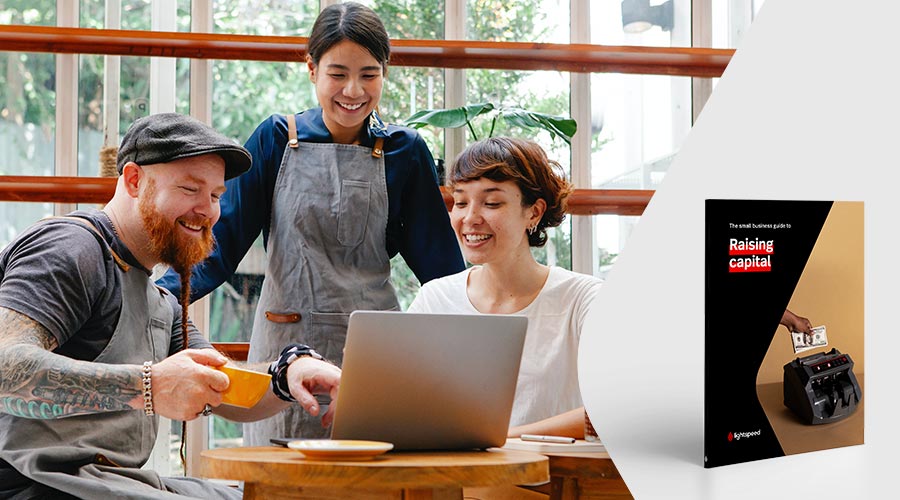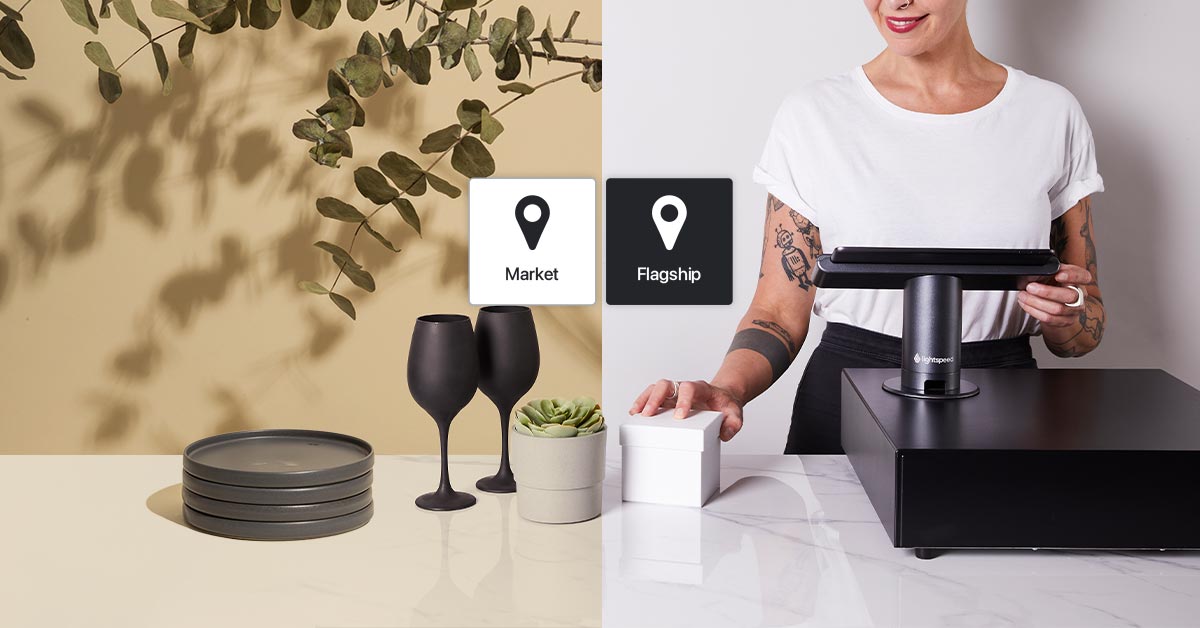You’re already operating multiple locations, or they’re in your business plan for the future—you know how valuable it is to have a presence in more than one place.
But even if it’s not time to commit to a whole new store just yet, outdoor sales, events and pop-up shops can still help you reach new customers with exciting deals and experiences. With the world opening back up and shoppers ready to get back out on the streets, this summer is your chance to grab a piece of the magic.
In this post, we’ll go over:
The Small Business Guide to Raising Capital
Time to grow? Learn how you can secure funding for your business goals.

So what’s the deal with pop-up stores and temporary locations?
After a rough year, retail is on the upswing. The National Retail Federation (NRF) forecasts sales to exceed $4.44 trillion as the economy recovers and shoppers get back out to stores. As vaccination rates increase, it becomes safer to hold events again, bringing more people outside this summer.
Retail rents in many cities are lower than they’ve been in years. In New York, even the most high-end retail districts have a higher-than-usual number of vacancies, opening those storefronts up for new tenants with lower leases.
These facts add up to one thing: there’s never been a better time to look into how to do a pop-up shop—or an event, a sidewalk sale or any other kind of temporary location.
Pop-up shops, sidewalk sales and booths at events help you:
- Scout out new permanent locations. Events and pop-up shops give you a chance to see what the customer base is like in new areas. Pop-up shops in particular can help you gauge the foot traffic of a location before committing to a longer lease.
- Market your brand to new customers. A sale on the street, an attractive setup at an event or an eye-catching pop-up shop all serve to put your products and business in front of shoppers who have never been inside any of your locations before.
- Capitalize on high-traffic spots with lower leasing fees. Maybe your expansion plans don’t include a new permanent location in a prestigious, high-traffic-but-highly-expensive spot. But they could include a temporary location in that spot, one that you use to direct customers to your permanent locations. You could use this tactic when opening a location in a new city—use the pop-up or event table to direct shoppers from one area to another.
Should I open a pop-up shop or sell at an event?
Pop-up shops are bigger financial commitments than events and sidewalk sales because of the leases. They can also last longer and, as such, make more of an impression. Beyond the obvious, however, pop-up stores, sales and events serve different purposes for customers.
Sidewalk sales are nearly synonymous with steep discounts. They’re for attracting customers with great deals and clearance inventory.
Events put your business in front of customers who otherwise might not have sought you out, but—depending on the event—are looking for what you’re selling.
A survey of American shoppers found that the top reasons for shopping at pop-up shops were:
- Unique and exclusive products or experiences
- Curiosity, excitement, entertainment
- Supporting local businesses
Pop-up shops aren’t just for sales. They can also sell products that customers can’t get at your regular locations and giving customers exciting experiences that they don’t usually have in their shopping trips downtown.
While you can have sales at a pop-up shop—they definitely get people in the door—and there are no real downsides to an air of exclusivity at a sale or event, the fundamental differences are important. Your pop-up shop, high-concept or not, should offer more than what shoppers can get at your permanent locations.
As such, whatever type of temporary location you decide to pursue should line up with your goals.
- Do you want to clear out inventory in a way that catches the eyes of foot traffic? Do a sidewalk sale in front of your busiest location.
- Do you want to alert tailored audiences of shoppers to your business? Set up a booth at an event.
- Do you want to market your business to a new area and customer base using a unique, exciting experience? Start looking into how to do a pop-up shop.
It may be that all three are right for your business goals. They aren’t exclusive marketing tactics by any means.
How much does a pop-up store or event cost?
There are no concrete figures for pop-up shops, sidewalk sales or events. There aren’t even many ballpark figures; the costs of rent, marketing, booth rental, insurance and more vary from city to city, event to event.
That doesn’t mean you need to go into your temporary location with no idea of what it will cost you, however.
Calculating the average cost of a pop-up shop
Think of evaluating the cost of a pop-up shop like you would a new location. The biggest difference is how the rent will be handled—most pop-up shops last between two weeks to two months.
At the very least, you’ll need to budget for:
- Rental fees
- Utilities, if they’re not included in rental fees
- Employee salaries
- Hiring and training costs, if you’re not planning to use your current staff
- Marketing to let shoppers know where to find you
- Inventory, even if you’re planning on transferring stock from your permanent locations to your pop-up shop
- Extra inventory costs if you’re planning to offer exclusive merchandise
- Shelving, hanging racks, display cases and accessories costs, if not included in the space
- License and permit fees, such as a sales tax permit
- Legal fees, as you should consult a legal expert on what you’ll need to operate
- Point of sale (POS) system costs, so you can take payment in anything other than cash
Pop-up stores can get expensive, but they’re valuable marketing tools. When you pick your location and inventory well, they often pay off, just like a new permanent location.
Calculating the average cost of a sidewalk sale or other event
Like pop-ups and new locations, having a table or a booth at an event requires budgeting for labor and inventory.
However, because you won’t have your own contained building, you’ll likely be paying much less in rental costs. You also may need to factor in storage costs if you’re planning on selling at the event for more than a day.
A sidewalk sale or event booth will cost less than a pop-up shop, but they’ll also be shorter-lived and may bring in less profit for it.
How to do a pop-up shop or temporary location
So you’ve picked your temporary location. You’re going to hold a pop-up shop in an up-and-coming part of town, or you’re going to sell a selection of your inventory at a local music festival, or whatever else you’ve settled on.
Getting your lease signed, or your table at the event secured, or your permit—if needed in your city— for a sidewalk sale sorted is just the beginning. Beyond making your temporary location look attractive, you’ll need to:
1. Decide what your goals are
Do you want to gather customer emails for marketing campaigns? Clear out old inventory? Entice customers to visit your permanent locations? Are you looking to evaluate the foot traffic and profitability of a location? Set concrete goals you can track and revisit after your pop-up shop closes or the event ends.
Tip: Lightspeed merchants can use Lightspeed Analytics’ report builder wizard to help them track their sales goals.
2. Set up your point of sale system
Whether you’re holding a sale outside of your flagship location or you’re opening a pop-up shop in a new city, you’re going to need a point of sale system to manage your sales and inventory.
A cloud-based POS system will serve you well here. For an event or a sidewalk sale, you’ll just need to add an extra digital register to your store in your POS software and equip your employees with an iPad. As long as you have a wifi connection—or a data hotspot—you’ll be able to make sales outside of your store.
But getting a POS system up and running for pop-up shops is way more work, right? Not necessarily! With a system like Lightspeed, you can add an extra location to your account, duplicate your inventory, and be ready to move on to the next stage of setup. In addition to being quick to launch, this setup has the benefit of visibility—even if your pop-up shop is far from any of your other locations, you can check on all your sales and transfer items between stores from the same backend.
3. Acquire and organize your inventory
Now that your POS is set up, you’ll need to arrange for the inventory you’re planning to sell.
If you’re holding a sidewalk sale, there’s nothing you really need to do beyond making sure your discounts are set up.
If you’re planning on selling exclusive merchandise at an event, you’ll need to make an inventory entry in your POS.
A POS system like Lightspeed will keep track of what you sell at your sale or event, automatically adjusting your inventory levels. When the sale or event is over, you won’t have to spend hours reconciling your inventory for that location—it will have been syncing all along.
If you’re managing a pop-up shop, this step is a little more complicated. You’ll need to decide how you’re getting the inventory for your shop. Are you transferring stock from your other locations, or are you buying all-new stock for the pop-up? When the pop-up is finished, which location are you going to send any unsold stock to?
Let’s say you’re a Lightspeed user, planning to do a bit of both options in your pop-up shop. You might:
- Transfer items between locations in Lightspeed Retail. This process is simple; just initiate an inventory transfer in Lightspeed, take or ship the items in question to the pop-up shop and accept the inventory transfer. The stock levels in your POS will stay updated per location.
- Create a multi-store purchase order to buy stock for your permanent locations and your pop-up shop. Two birds, one stone—Lightspeed’s built-in multi-store purchase orders (called master orders) mean you’ll be able to stock up for all your locations at once.
4. Make a Plan B for stockouts
If your sidewalk sale’s goal is to clear out old inventory, stockouts aren’t a problem for you—they’re a goal! Likewise, if your event or pop-up shop is selling some exclusive merchandise, there isn’t much reason to restock limited-time items.
But for the most part, empty shelves turn customers off at pop-ups and events just as much as they do in regular stores. You could:
- Transfer items from other locations to the one hosting your event, or to your pop-up shop. As we’ve said, this is a straightforward process with Lightspeed. You don’t want your POS working against you.
- Direct customers to your other locations. If you have other locations in the city your temporary location is set up in, you could simply send customers there—but you risk them not making the trek.
- Take eCommerce orders for customers, or direct customers to your eCom store. If one of your other locations has the item they want in stock, you can help them order it online.
5. Prepare your employees
Whether you’ve hired extra temporary staff or you’re using your existing employees, you’ll need to make sure they know how to do a pop-up shop, sale or event. Let them know what your goals are and what they’ll need to do to achieve them.
For example, if you’re looking to increase your awareness among a new customer base, you could direct your employees to fill out customer profiles for everyone who stops by to purchase something. As you gather up email addresses—and consent to contact them—you’ll be able to expand your email marketing efforts.
You could also put emphasis on employees helping customers sign up for your loyalty program. Though your location is temporary, your loyalty program is not, and you can use it to direct customers to your permanent locations.
Tip: Lightspeed Loyalty is omnichannel, so even customers in cities you don’t have permanent locations in can become regulars by earning rewards through your eCom store.
Learn from your pop-up shop or event
Pop-up shops and events aren’t just good for increasing sales with a new cohort of customers. They also help you gather valuable data that you can use as you grow your business.
If you liked where your pop-up shop was, you can keep a line of communication with the landlord open for a future permanent location. If you found that the foot traffic wasn’t as high as you’d have liked, you know you need to scout out other neighborhoods for your next event.
If you brought in an exclusive item or line for your event, and it sold well, that could be a sign. Maybe it’s time to bring products like it to your permanent locations?
Whatever you’ve learned from your temporary location, one thing should be clear: hosting these exciting experiences is easiest when your point of sale software is on your side. If you’d like to learn how to do a pop-up shop with Lightspeed’s one-stop commerce platform, get in touch.
Looking For Restaurant Billing Solution?
Call Pursho @ 0731-6725516
Telegram Group One Must Follow :
For Startups: https://t.me/daily_business_reads
#PopUp #Shop #Event #Catching #Eyes #Temporary #Locations







